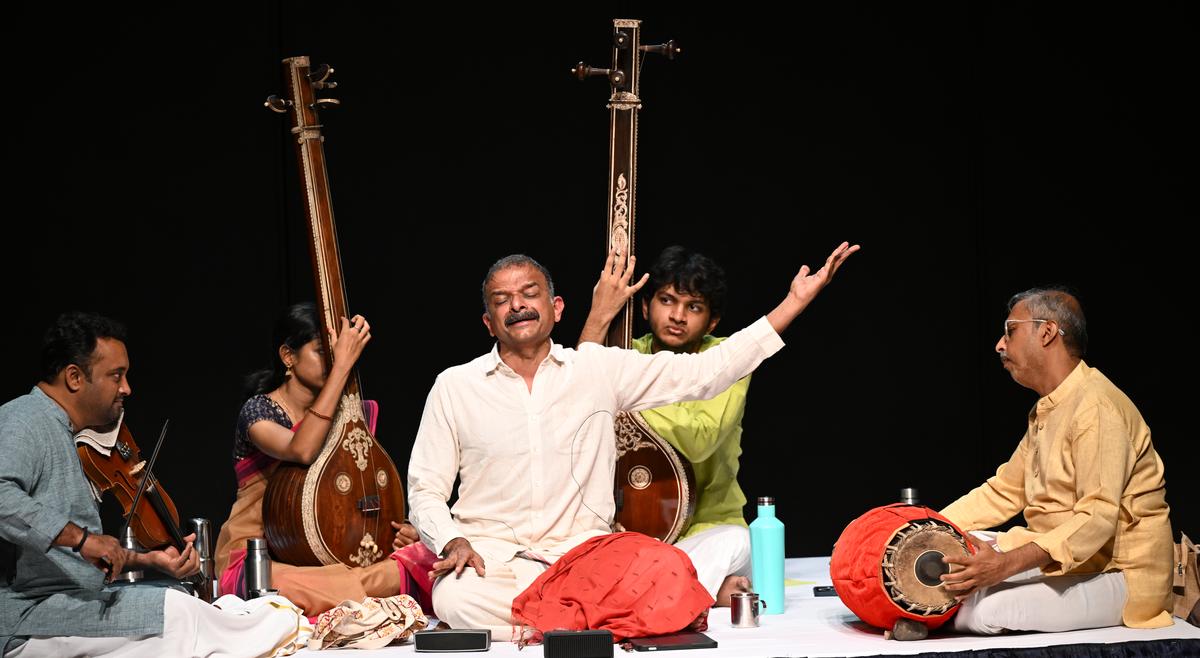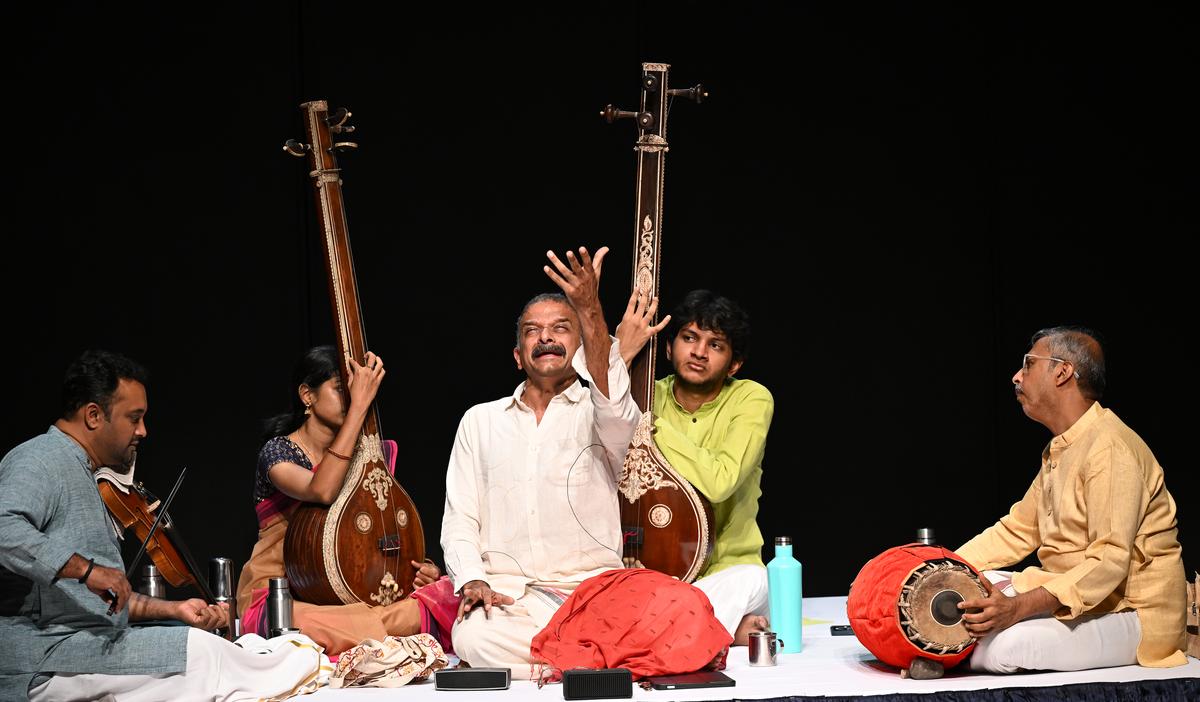T. M. Krishna performing at M.S. Subbulakshmi auditorium in Chennai.
| Photo Credit: M. SRINATH
The unpredictability is what makes a T.M. Krishna concert special and his recent performance at the Asian College of Journalism’s M. S. Subbulakshmi auditorium in Chennai did not fail to disappoint the audience in this respect. Till today, Krishna is the only Carnatic musician who has the ability to elicit contrasting opinions from two music lovers who may even identify as his die-hard fans. His experiments with the format and manodharma could annoy someone who is emotionally attached to a particular composition and they may feel that his tampering is unjustified. While the other could simultaneously squeal with joy at the attempt and wonder how he is able to pull off such moves with elan and aesthetic sense.
Such is Krishna spontaneity that even a padam, quite often sung by him in his concerts, sounds different each time one hears it. Padams have been glorified not only for their musical nuances but for the unmatched erudition they lend to intimate settings. The auditorium, which is acoustically designed for performances without any form of electrical amplification, enabled the audience to hear even the micro sangatis that Krishna generously improvised in the pallavi of ‘Yaarukagilum’, a sringara padam, symbolic of rebellion. His demonstration of about half a dozen ways to end the phrase ‘Penne’ exhilarated the listeners.
Also read: T.M. Krishna’s Tyagaraja Aradhana concert sparkled with classicism
One of Arun Prakash’s significant contributions to the arrangement is no doubt his no-fuss arudis; here it rounded up the anupallavi and carefully connected it to the charanam. The charanam ended with the phrase ‘Kasugusena’ at the upper gandharam. A round of swaras was rendered by Krishna at this point with a set of whirlwind phrases that touched the lower and upper gandharams in a wild way. Just when one thought this was not enough of a deviation, Krishna next chose to explore the mandra sthayi with a round of swaras at ‘Enna’ in the pallavi. One must say this was an astute choice to use the setting effectively as the auditorium facilitated even the lowest mandra sthayi phrases to be heard clearly.

Krishna with Arun Prakash on the mridangam and H.N. Bhaskar on the violin
| Photo Credit:
M. SRINATH
One of the pieces that Krishna chose to present was ‘Shubh sukh chain’, a Hindustani translation of Rabindranath Tagore’s poem ‘Bharoto Bhagyo Bidhata’ whose first stanza is used as the national anthem. Rewritten by Subash Chandra Bose with the help of writer Mumtaz Hussain and Colonel Abid Hasan Safrani, the song is a reimagination of the national anthem and makes significant departures from the original text and melody. Krishna mentioned that he chose to present this piece as certain verses in it echoed his thoughts on nationalism.
Possibility is what Krishna has shown the Carnatic music world from the beginning. Take for instance his dissecting of the Surutti nishadam. Without going into many of its standard phrases, he chose to exhibit how much the madhyama to upper nishada section can be exploited to get the best out of the raga. Next, he added the shadjam to panchamam layer , later moving on to approaching the nishada from the upper rishabham.
H. N. Bhaskar set out on a similar expedition to unearth the potential of ‘Ni’ in Surutti when Krishna interjected to infuse the kakali nishadam into the alapana to make it into a soulful Desh. Ultimately however, the kaishiki nishadam reigned supreme and wrestled itself back to become Brindavana Saranga. Muthuswamy Dikshithar’s ‘Soundararajam’ was rendered at a breezy pace leading up to the thani. Arun Prakash provided a seamless stream of soft strokes throughout the composition and his thani was a direct extension of this sophisticated approach. Some would even be bold enough to ask if what they heard was a ‘Soundararajam’ in the middle of that incessant mridangam flow — such was Arun’s melodic presence that evening.

Krishna performed a mikeless concert at the Asian College of Journalism.
| Photo Credit:
M. SRINATH M
Eminent poet Perumal Murugan’s poems on birds are filled with beautiful imageries and employ tasteful alliterations . His fascination with the Indian Roller known as ‘panangaadai’ in Tamil resulted in him going through the works of M. Krishnan, a world-renowned ornithologist. Murugan was particularly intrigued by the fact that the Roller lives in solitude and barely makes any kind of noise. Tuned and presented by Krishna in Khamas, the composition uses some characteristic phrases involving the kakali nishadam to highlight the unique features of the bird in the lines ‘neela nira rakkaiyai serkka virithu sellumbodhu’ and ‘porambaai padakkendru paayum’. They talk about the bright blue markings on its wings, which are prominent in flight, and its tendency to display aerobatic twists and turns.
Asking Bhaskar to take up an alapana, Krishna observed as the violinist played a clear Mayamalavagowla alapana. During his turn, Krishna tactfully removed the daivatam to turn it into Jaganmohini topping up the segment with superfast one-avartana swaras for ‘Sobillu Saptaswara’.
Many in the audience were happy to hear him sing ‘Bhare Panduranga’ and felt that it was apt post-Ashadi Ekadashi. When rendering ‘Koluvamaregada’ in Todi, Krishna’s neraval at ‘Tambura jekoni’ was punctuated by meaningful pauses where the harmonic drone of the two tamburas on stage accentuated the mood of the sahitya.
Krishna will always be the musician who has taught a whole generation how to unshackle art from orthodoxy. The only pledge we all must take is to allow diverse forms of artistic expression to co-exist in harmony, without one overpowering the other.